Quaker Parrot: Pictures, Personality, Food & Care Guide
Updated on
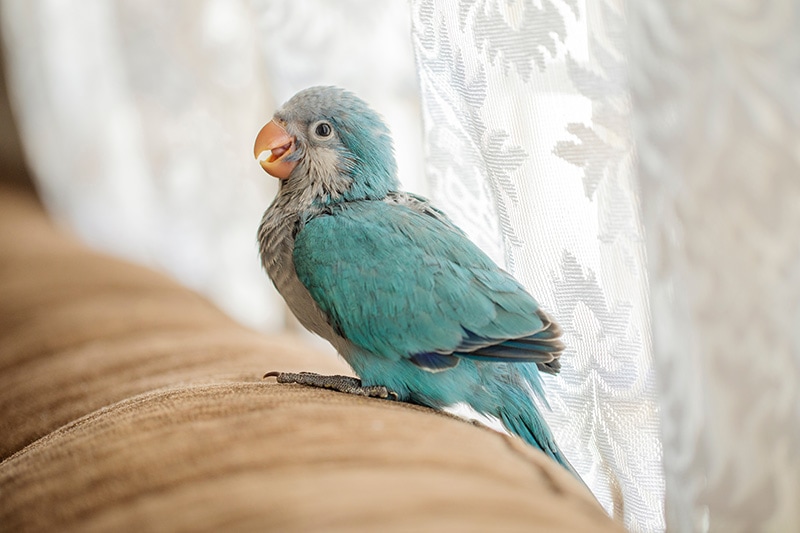
Click to Skip Ahead
Also known as the Monk parakeet (Myiopsitta monachus), Quaker parrots are one of the most entertaining and unusual pet birds you’ll find. They’re native to South America, but small feral populations of Monk parakeets live in various cities across the USA, including Chicago, New York, San Diego and Miami. Do you know any other pet parrot that maintains thriving wild populations in multiple U.S. cities? How do they do it? Keep reading to find out!
Species Overview
| Color: | Blue, green |
| Size: | 11-13” |
| Weight: | 3.5-5 oz |
| Wingspan: | 19-20” |
Few pet parrots are as well known for their personalities and vocal abilities as the Quaker. They are one of the smallest parrot species that can learn to talk. Quaker parrots are generally easy to tame and can learn tricks and behaviors due to their high intelligence.
Like most parrots, they can be high-maintenance and noisy. Quaker parrots don’t make the best neighbors, and depending on where you live, it may not be legal to own one, either. In this article, you’ll learn everything you need to know about keeping a Quaker parrot as a pet. At the time of writing, Quaker parrots are listed by the IUCN Red List of Threatened Species as a species of Least Concern.
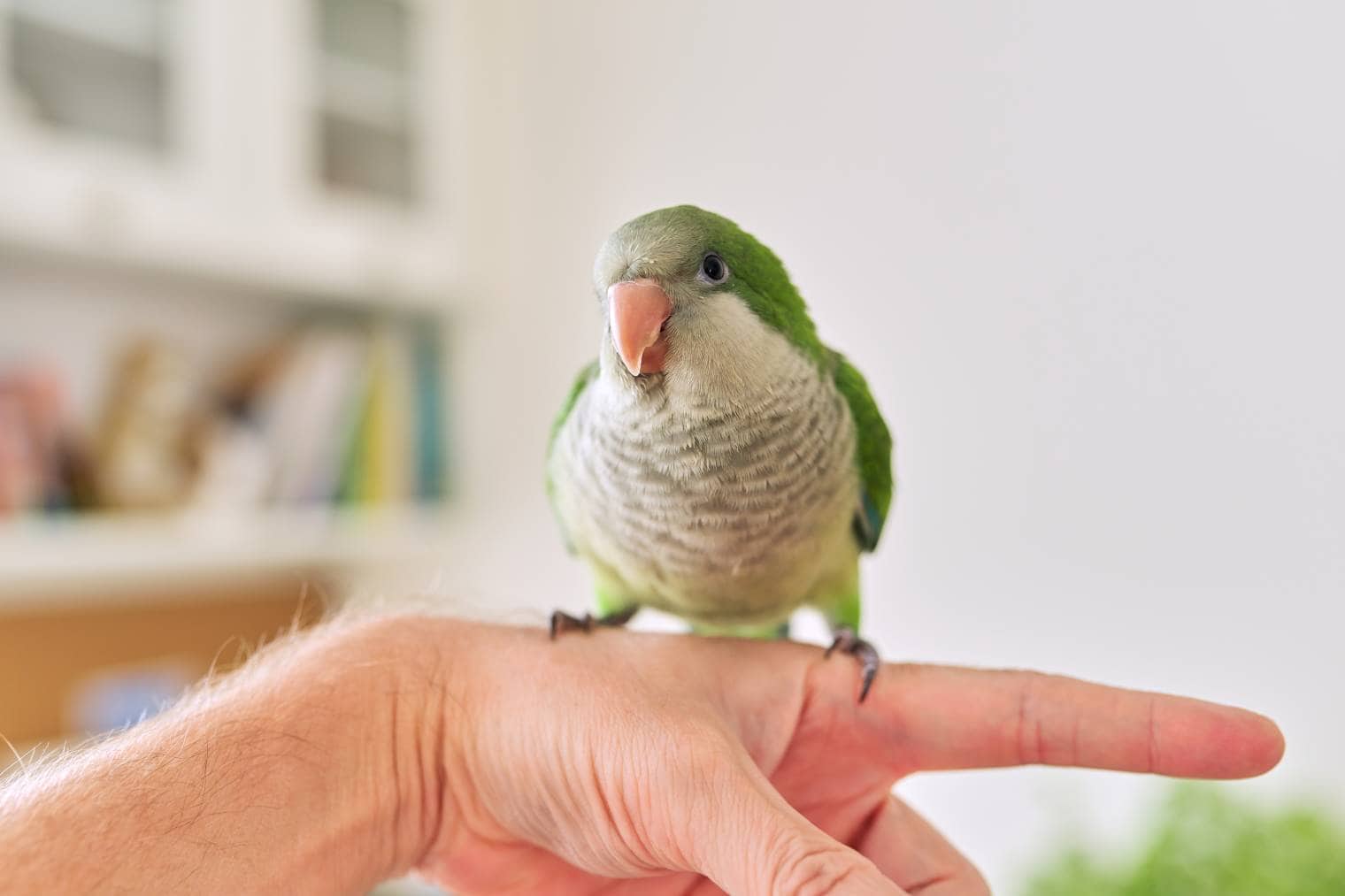
History & Natural Habitat
Quaker parrots are native to South America, specifically Bolivia, Argentina, and southern Brazil. However, they are one of the most adaptable species of parrots, and wild populations are now found in many countries outside their native habitat, including the United States. They prefer forest environments because they build nests in elevated spots.
Quaker parrots are social birds that live and nest in large groups. They are the only parrot species that builds nests out of sticks rather than using hollow trees or other locations. These nests can be large and heavy.
Wild Quaker parrots forage for seeds, fruits, nuts, and blossoms during the day. They are also known to eat crops like wheat and corn. In the U.S., you’ll also spot them at bird feeders during the winter.
Quaker parrots are considered a species of least concern, with populations still thriving in South America. Wild populations in the United States are also stable, if not spreading as quickly as once feared.
Things to Know When Owning a Quaker Parrot
Temperament
Quaker parrots are often called the comedians of the bird world. They are well-known for their friendly temperament, vocalization, and zany antics. If you want a bird with a huge personality, the Quaker parrot is what you’re looking for.
Intelligent Quaker parrots can learn several tricks, including how to talk. They are constantly on the move and can be highly entertaining to watch. It’s best to begin handling these birds at a young age.
Quaker parrots need frequent social interaction and attention. Without it, they may develop problems, such as feather picking, destructive behavior, or excessive vocalization. Quaker parrots can be territorial and often bond closely to one person.
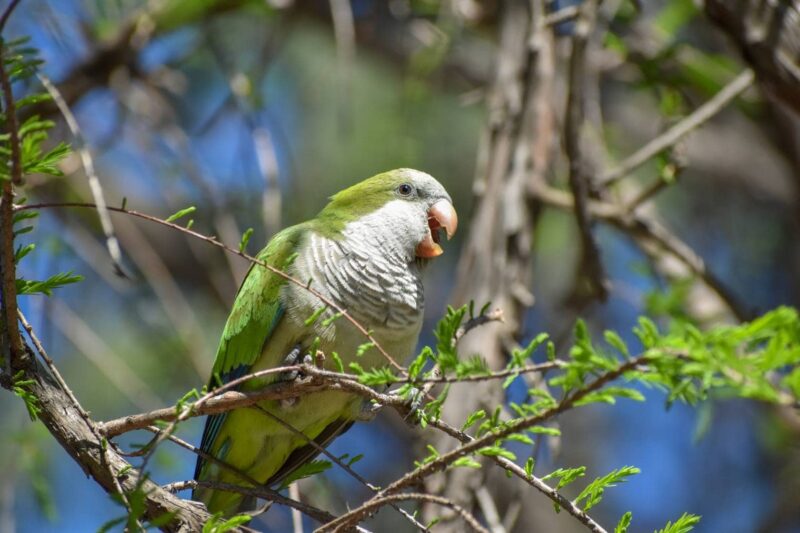
Sounds, Speech & Vocalizations
Quaker parrots are particularly noisy birds. In the wild, they demonstrate at least eleven separate vocalizations. While flying, Quaker parrots call each other with loud squawks. Perching birds prefer to speak in a quieter chatter. Pet Quaker parrots can generally be taught to mimic human speech fairly easily, but not all birds will learn to talk. They are one of the most talkative species of small parrots, which is why they are such popular pets.
Quaker Parrot Appearance
Quaker parrots are considered small-medium birds, averaging about 1 foot in length. They have comparatively large heads with a hooked, pale pink beak. Quaker parrots also have long, pointed tails.
Most Quaker parrots are green with a light gray head and breast. Their underwings are typically dark blue and visible in flight. Males and females are similar in appearance and can only be sexed with DNA testing on blood or feathers.
Some other colors rarely occur, thanks to genetic variations. Shades of blue, yellow, white, and cinnamon may all be found. If you want a pet Quaker parrot in one of these rare colors, expect to pay more and spend time searching for an available bird.
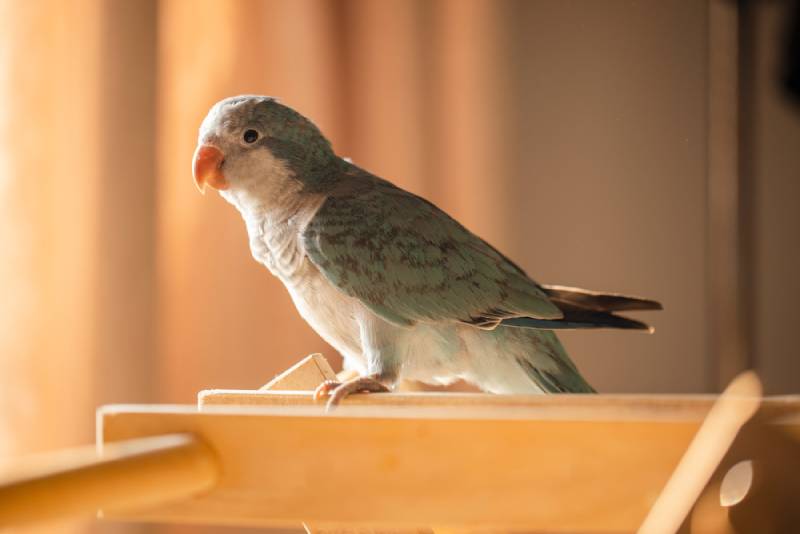
Caring For the Quaker Parrot
For relatively small birds, Quaker parrots require quite a bit of daily care and interaction. Here’s what you need to know about caring for the Quaker parrot.
Diet & Nutrition
Quaker parrots are predisposed to heart attacks and strokes, so the amount of fat in their diet needs to be controlled carefully. Birds that are fed a diet rich in seeds tend to suffer from high blood cholesterol and the deposition of cholesterol in the arteries (known as atherosclerosis). This contributes to the likelihood of a heart attack or stroke in an already predisposed species.
To avoid this, commercially formulated pellets should make up about 70% of a Quaker parrot’s daily diet. Seeds and nuts should only be fed in very small quantities, and never as a sole diet.
In addition to pellet food, Quaker parrots should be offered an assortment of vegetables, leafy greens and smaller portions of fruit. These should make up about 20% of the Quaker parrot’s diet. Here are some safe fruits and vegetables to consider:
- Leafy greens
- Apple (without seeds)
- Berries
- Squash
- Zucchini
Quaker parrots can develop preferences for certain foods, so try to rotate the fruits and vegetables you offer.
Occasional treats such as a piece of boiled egg or a commercial treat can be given, but moderation is key, particularly in this species. Supplements are often recommended for pet birds, specifically at certain points of life. Ask your veterinarian before offering any supplements to your Quaker parrot. They also need fresh water daily.
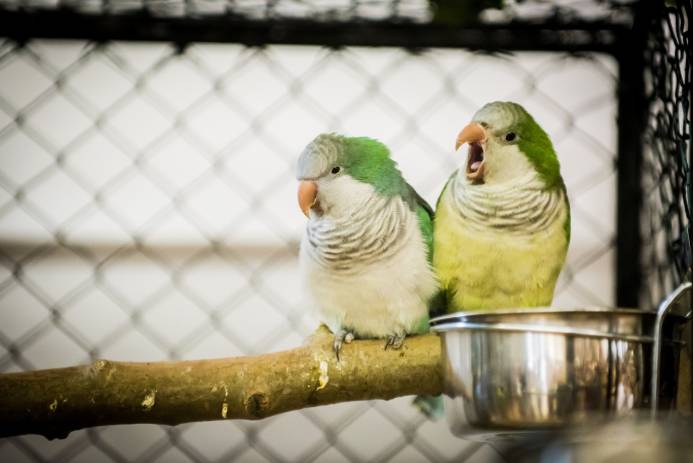
Cage/Housing Requirements
Quaker parrots are active birds and will appreciate having as much space as possible. Aim for a cage at least three times as long and wide as their wingspan and four to five times their wingspan in height. The bird should be able to stretch their wings without hitting them on the sides of the cage and fly back and forth from perch to perch.
Clever Quaker parrots are escape artists, so make sure the cage bars are no more than 5/8” apart. This allows the birds to climb but keeps them contained. Quaker parrots don’t need bedding, but the cage should contain multiple perches at different levels, and these should be made out of natural materials such as fruit tree branches. Food and water dishes, toys, and other enrichment objects.
Make sure your pet’s toys are plentiful and bird-safe. Quaker parrots enjoy shredding cardboard and playing with store-bought toys. They also like puzzle toys that allow them to perform natural foraging behaviors. Rotate toys around so that there are always new ones to play with.
Exercise
Quaker parrots should spend as much time out of their cage as possible every day. A minimum time of 3 hours out of the cage is recommended. They may enjoy interacting with other birds, but, not always, and therefore should be kept separated due to their territorial nature. With or without other birds, the Quaker parrot will need frequent human interaction to fulfill their social needs.
Ensure the bird only spends time in a secure, bird-proof area where they are safe from other pets, ceiling fans, electric cords, and other household hazards. The smaller the parrot’s cage, the more time they need to spend outside of it each day.
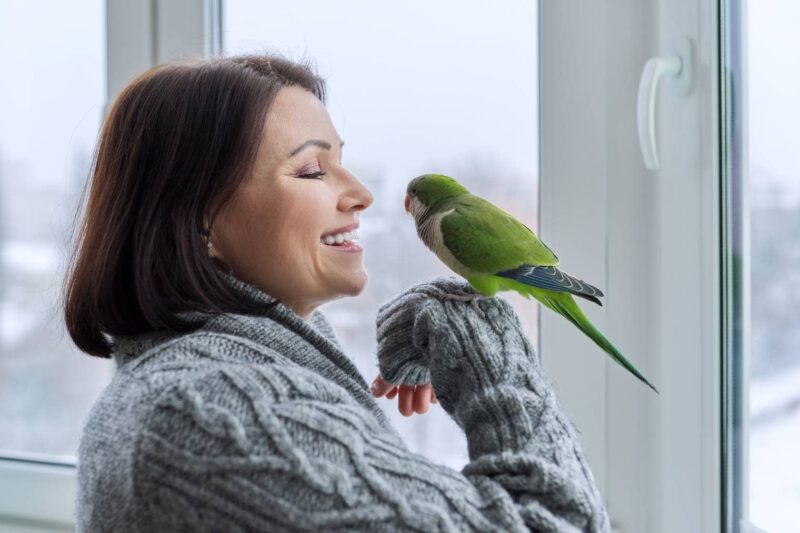
Health & Conditions
Many health conditions in Quaker parrots occur from improper nutrition and handling. Keep their nails trimmed and monitor their beaks for deformities. Perches of different widths will help exercise the bird’s feet, and cuttlefish bone will help prevent beak overgrowth, as well as supplement calcium. Cover the cage for at least 12 hours at night to prevent reproductive issues like egg binding. Make sure their cage and toys don’t contain any heavy metals, like lead.
Ultraviolet lighting should be provided for all birds for 12 hours a day, to help with calcium metabolism, reproductive hormones and the bird’s immune system. Windows filter out UVB light so putting your bird near the window will not help.
- Psittacosis (caused by the bacteria Chlamydia psittaci)
- Obesity and atherosclerosis
- Heart attack/ stroke
- Pancreatitis
- Feather destructive behaviors
- Liver disease
- Poisoning from fumes, aerosols or heavy metals
- Vitamin A deficiency
3 Little-Known Facts About The Quaker Parrot
1. They Are Illegal to Own in Some States.
Before you purchase a Quaker parrot, double-check that you aren’t breaking the law. Quaker parrots are considered an invasive species in many areas, and owning them as pets is forbidden. Quaker parrots are illegal in Pennsylvania, California, Connecticut, Colorado, Georgia, Rhode Island, Wyoming, Tennessee, and Kentucky. Spain and Western Australia have also outlawed the ownership of Quaker parrots.
2. They Have Lived Wild in the United States for Decades.
Quaker parrots live wild in multiple parts of the United States, including cold-weather cities like Chicago and New York. Wild populations were established as far back as the 1960s by escaped or intentionally released pets. These wild Quaker parrots compete with native birds for food and nesting space. They are noisy in large groups and can destroy crops, so they are considered an invasive species.
3. Their Nests Can House as Many as 200 Pairs of Birds.
Quaker parrot nests provide year-round community housing for multiple breeding pairs. Most nests contain at least 20 nesting chambers, but they can be expanded to hold as many as 200. The nests can weigh as much as a ton and stretch to 5 feet across.
Conclusion
Many pet owners mistakenly think exotic pets are easier to care for than dogs and cats. As you learned in this article, that’s often not true, especially in the case of pet parrot species. These birds demand daily attention, a varied diet and lots of enrichment. Quaker parrots in particular need a lot of attention and they won’t be happy if they don’t get it.
Fortunately, they also provide plenty of entertainment in exchange for that attention. If you have the time and space to care for a Quaker parrot properly, they can provide years of companionship. Just be sure to confirm it is legal to own a Quaker parrot in your state or town, and do thorough research first. Ensure you know where your Quaker bird has come from and have the correct set-up and time to provide a happy home for your new pet.
Featured Image Credit: V.S.Anandhakrishna, Shutterstock











